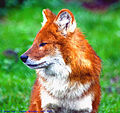| DescripciónFlickr - law keven - Feeling Ruff...HBWE Everybody..-O)).jpg |
Asian Wild Dog or Dhole - Howletts Wild Animal Park, Kent, England - Sunday November 16th 2008.
Click here to see the Larger image
Click here to see My most interesting images
From Wikipedia, the free encyclopedia ~ The Dhole (Cuon alpinus), also known as the Asiatic Wild Dog, Indian Wild Dog or Red Dog is a mammal of the order Carnivora, and the only member of the genus Cuon.
Description ~ The Dhole bears many physical similarities to the African Wild Dog and the Bush Dog, most notably in the redundancy of the post-carnassial molars, though whether this is an example of convergence or close relationship is a matter of debate.
The Dhole typically weighs 12-20 kilograms (26-44 pounds) and measures 90 centimeters (35 inches) in body length and 50 centimeters (20 inches) shoulder height. The tail measures 40-45 centimeters (16-18 inches) in length. There is little sexual dimorphism. The Dhole has a broad, domed skull and a short, broad muzzle. The bones of the forehead and upper jaw are "swollen", producing a dish-faced profile. The hooded eyes have amber or light brown irises, and the ears are large and rounded.
The pelage of the back and flanks is red to brown in colour, while the foreneck, chest and undersides are white or lightly gingered. The fur of specimens from southern ranges is typically short and rusty red, while that of more northern subspecies is longer and more yellow or brown in colour. Dholes from Thailand are more uniform brown, and lack the typical lighter throat and chest, while those from Himalayan regions have more yellowish fur.
Dhole dentition is unique among canids, by the fact that it has one fewer lower molars, amounting to 40 teeth rather than the more usual 42 of other species. Its lower carnassials also sport only one cusp (two is more usual for canids) an adaptation thought to improve shearing ability, thus allowing it to compete more successfully with kleptoparasites. Its front pawpads are fused at the base. Females have 6-7 pairs of mammae, as opposed to the more usual five present in other canid species. The chromosome number is 2n = 78.
Reproduction ~ Sexual dimorphism is not very distinct with no quantitative anatomical differences known. Both males and females become sexually active at one year old, though females usually breed at 2 years in captivity, and in the wild, for the first time at 3 years, possibly due to physiological and behavioural restraints. Females exhibit seasonal polyoestrus, with a cycle of around 4-6 weeks. Pups are born throughout the end of fall, winter, and the first spring months ( November - March ) - dens are earthen burrows, or are constructed amongst rocks and boulder structures, in rocky caverns, or close to streambeds. In East Java, the Dhole is thought to mate mainly between January and May. Unlike some other canid species, the Dhole does not engage in a copulatory tie when mating. Also, mating is not as restricted to certain individuals as it is in wolf packs, in which usually only the dominant pair can breed.
After a gestation period of around 60-62 days, females usually give birth to about eight pups (though the range is 5-10, the record is 12, and sizes vary drastically within the same pack through different years), which weigh 200-350g. Dhole growth rate is faster than that of wolves, being similar in length to that of the coyote. At 10 days their body weight has doubled, and body length is 340mm. Pups are weaned between 6 and 9 weeks. In captivity, weaning is sometimes recorded later on in the range. By 8 weeks, younglings are less quarrelsome and aggressive, and more vigilant. At three months litters go on hunts, though the pack may not be fully mobile until eight months. Young reach sexual maturity at about a year, and full adult size at 15 months.
After birth, a few other adults will help to feed the young of the dominant pair. The pups, as early as the age of three weeks, and the mother are fed regurgitated meat. When lone females breed, rearing the litters only results in limited success.
Diseases ~ Dholes are in danger of catching infectious diseases when they come in contact with other animals, especially canines – including feral and domestic dogs. They have been known to suffer from mange, canine distemper, and trypanosomiasis. Canine parvovirus was recorded in Dhole populations in Hodenhagen, Germany and Chennai, India zoos. Sporadically, the Dhole is a health risk for human beings, since their excreta contain transmittable pathogens (e.g. Toxocara canis). Dhole waste has also been found to contain roundworm, cestodes, and other endoparasites. Like other canines, the Dhole can catch rabies; in the 1940s, rabid Dholes bit and infected villagers in the Biligirirangan Hills in India. |

